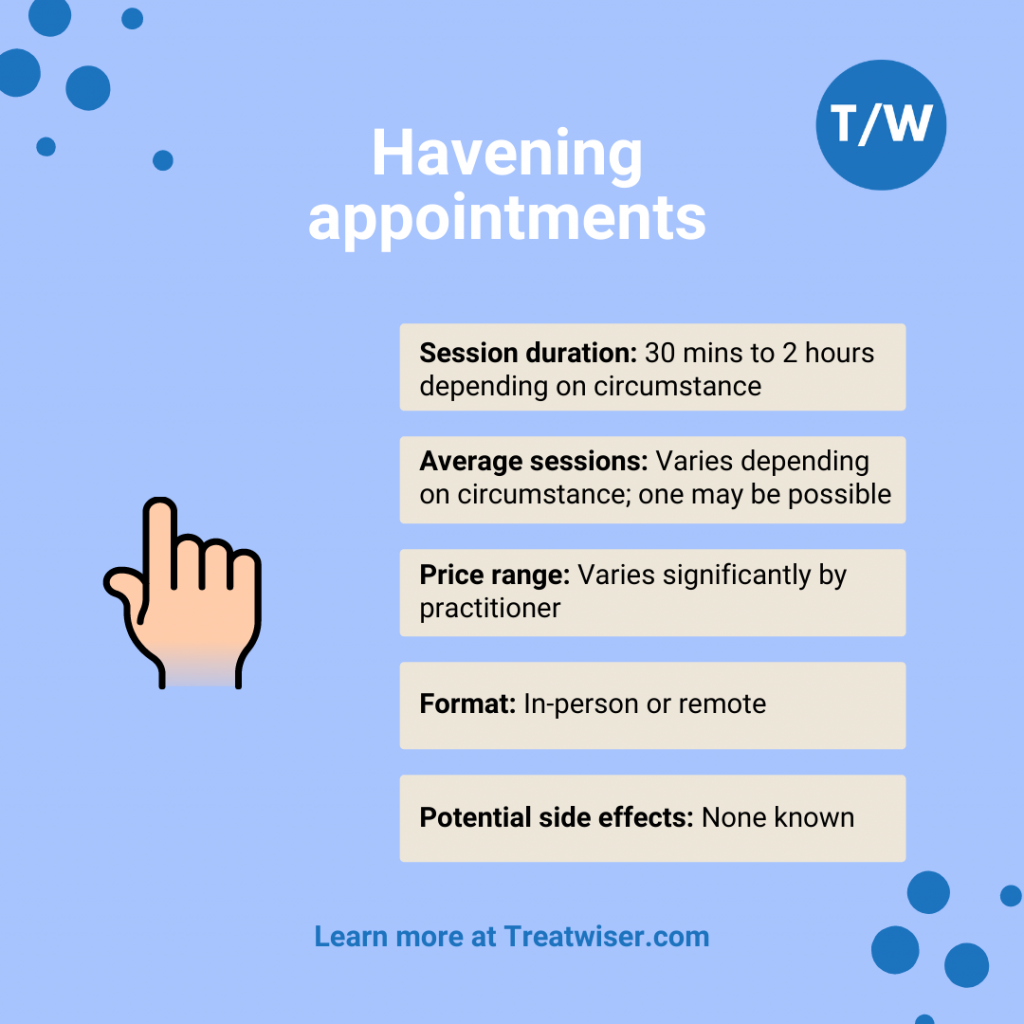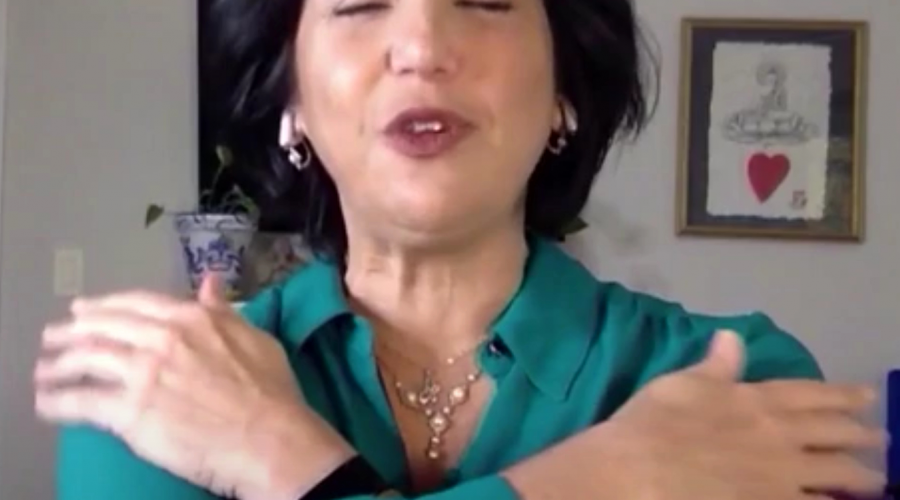All of us have bad experiences from time to time. For some of us though, through no fault of our own, the result can be trauma in the form of a phobia, anxiety, panic attacks or other emotional consequences. Havening TechniquesⓇ are an amazingly simple set of processes which can help you to overcome and even eradicate life limiting negative emotions.
Table of contents
- 5 interesting facts about havening
- What are Havening Techniques?
- What is the theory behind Havening Techniques?
- When and how are Havening Techniques used?
- What is the evidence to support Havening Techniques?
- What can I expect as a Havening Techniques patient?
5 interesting facts about havening

What are Havening Techniques?
Havening is a method for treating negative emotions – such as anxiety, fear or panic – by using the power of touch, more specifically stroking of the upper arms, face, and palms.
Stroking these parts of the body are all things which you can observe yourself or other people people doing naturally on a daily basis as a way of soothing, comforting or reassuring themselves or others.
In Havening Techniques, the power of touch is used in a systematic way to lessen and even remove negative emotions. It does not involve hypnosis and it does not require you to believe that it will work.
It is something that you can do for yourself, though in the first instance it is probably best to work with a registered Havening Techniques practitioner who will be trained in the full range of techniques.
Note: Havening Techniques is a registered trademark of Ronald Ruden, 15 East 91st Street, New York.
What is the theory behind Havening Techniques?
The fight or flight response
You may well have heard of the “fight or flight response” which is the name given to changes in our bodies which occur when we feel under threat. They are called the fight or flight response because they have evolved to enable us to fight the threat or run away. They include:
• release of noradrenalin into the body;
• increase of heart rate and blood pressure;
• increase of breath rate;
• diversion of the blood supply from our non-urgent functions, like digestion, to our muscles;
• becoming more alert and vigilant with our attention focused on the perceived danger.
These changes all occur rapidly and without any conscious input to enable us to take immediate action to protect ourselves, and we experience them as feelings of fear, anxiety and anger.
The amygdala
The key area of the brain responsible for triggering the fight or flight response is the amygdala, a small almond sized area of the brain which has a primary role in the processing of memory, decision making and emotional reactions. We actually have two amygdalas – one on each side of the brain.
What normally happens after the amygdala sets off the fight or flight response, is that the front part of our brain evaluates the threat and, if it considers that we are safe, sends a message to the amygdala to switch off the response and we return to a state of calm.
However, if we don’t reach that feeling of safety, the amygdala may well store a memory of the scary situation so that the next time we find ourselves in a similar situation or even think about the memory, the fight or flight response is immediately triggered.
This is very useful if we are actually faced with physical danger, but not very helpful if these changes occur in situations where it is not appropriate to fight or run away, like taking an exam, or giving a presentation; or if the feelings of anxiety or fear are aroused by simply thinking about a past experience.
If we are regularly in a state of anxiety or anger it can have a very detrimental effect on our mental and physical health.
What does havening involve?
The basic havening technique is very simple:
1. We activate a stressful memory by remembering it and then rating the strength of the associated feelings out of ten, where ten is the maximum they could be.
2. We then apply havening while distracting our attention from the stressful memory by, for example, imagining walking on a beach, humming a tune, or counting aloud.
3. After a couple of minutes, we pause and rate the feelings out of ten. Usually, the intensity will have reduced.
4. Repeat this process until the intensity of the feelings subsides to zero.
Applying the havening touch – ie stroking upper arms, face and hands – when the memory is activated, sends a message to the amygdala that we are in a safe place, and the neural circuits triggering the fight or flight response can be switched off.
It is for this reason that Dr Ruden called the technique “havening” – meaning to bring to a safe haven.
Why it works
It is believed that stroking the arms, face and palms after activating a stressful memory produces delta waves in the brain which cause the neural circuits relating to the activated memory to be switched off. Delta waves are associated with reduced amygdala activity.
When and how Havening Techniques are used
Havening technique is used in a range of situations
People commonly seek out Havening Techniques for the following reasons, however more research is required to support its efficacy, and you should always speak to your GP or qualified medical practitioner before booking any appointments:
• Phobias
• Chronic pain
• Distressing memories (broken relationships, shocking news, loss, embarrassment, etc.)
• Anger
• Fear of abandonment
• Stress
• Self Esteem
• Cravings
• PTSD
• Panic attacks
• Sexual abuse
• Performance enhancement
• Public speaking
• Sports
• Emotional eating
Havening techniques
The original havening technique was developed to help people overcome anxiety or a phobia arising from a specific event. However, the fallout from a specific event can impact on life in many ways and a range of further techniques have been developed to help people deal with longstanding issues and develop resilience.
What is the evidence to support Havening Techniques?
Havening TechniquesⓇ are new. They appear to have promising emotional, mental and physical health benefits, but they have yet to be fully researched. So far there are two published research papers on havening, both of which showed positive changes after one havening session. Further information on these studies can be gained from www.havening.org.
What can I expect as a Havening Techniques patient
The havening appointment
Every havening appointment will be different. However, you can typically expect a havening session to include the following:
• a discussion of the help that you need;
• an explanation of havening and how and why it works;
• exploration of how any negative emotions you are experiencing originated;
• working on any negative emotions using havening;
• a demonstration of havening that you can do for yourself at home.
A havening session can take place online or in person. If in person, the practitioner will let you decide whether you would prefer the havening practitioner to apply the havening touch, or to do it yourself.

How do I find a havening professional and what qualifications should they have?
To find a properly trained and registered Havening Techniques practitioner, visit www.havening.org which has a directory of qualified and registered Havening Techniques practitioners all over the world.
How much does it cost?
Every practitioner will have their own scale of charges.
How many appointments will be needed?
The number of appointments you need will depend on the nature of the issue you want to work on. In some cases, a single session can be sufficient to resolve the issue. In others, a number of sessions over several months may be required. This is something which you can discuss with a registered Havening Techniques practitioner.
What are the risks associated with havening?
Havening is based on natural responses of the body. As such, it is not believed that there are any risks associated with it – provided that you work with a Registered Practioner.
Where can I find out more?
To find out more, visit www.havening.org which gives a lot of free information and some free resources.
You can also read “When the Past is Always Present” by Ronald A.Ruden
Note: Havening Techniques is a registered trademark of Ronald Ruden, 15 East 91st Street, New York.
DISCLAIMER: The Site cannot and does not contain medical / health advice. The medical / health information is provided for general informational and educational purposes only and is not a substitute for professional advice. Accordingly, before seeking any form of medical advice, diagnoses or treatment based upon such information, we encourage you to consult with your GP or other qualified health practitioner. You must never disregard professional medical advice or delay in seeking it because of something mentioned on this Site. The use or reliance of any information contained on the site is solely at your own risk.





